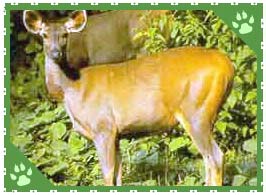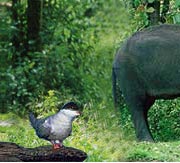 With more than 50 feet tall Sal trees, sunlight trying to touch the ground, dragonflies stretching out their wings under the tender warmth of the sun. Sitting firmly on the dew fresh leaves, they bask to recharge themselves for the day. The melodious chirping of koyal/cuckoo welcomes the new morning. The little sun rays which reach the ground weave a magical display of light and shadow on the canvas of dry leaves. This is what Dudhwa National Park, one of the largest and thickest forests in India, all about!
With more than 50 feet tall Sal trees, sunlight trying to touch the ground, dragonflies stretching out their wings under the tender warmth of the sun. Sitting firmly on the dew fresh leaves, they bask to recharge themselves for the day. The melodious chirping of koyal/cuckoo welcomes the new morning. The little sun rays which reach the ground weave a magical display of light and shadow on the canvas of dry leaves. This is what Dudhwa National Park, one of the largest and thickest forests in India, all about!Wildlife in Dudhwa National Park
The Dudhwa National Park is spread over 490sq km along with a buffer area of over 100 Sq km. Besides massive grassland and swamps, Dudhwa National Park is home to one of the finest Sal (Shorea robusta) forests in India. Some of these trees are more than 150 years old and over 70 feet tall. In 1976, the park had a population of 50 tigers, 41 elephants and 76 bears apart from five species of deer, more than 400 species of birds, crocodiles and some other species of mammals and reptiles.
Dudwa National Park is a stronghold of the barasingha/ swamp deer, which can be spotted in herds of hundreds. India is the only country where this species of deer is found. It is interesting to note that around half of the total Barasinghas on the Earth are present in Dudhwa National Park. Smaller than the sambar, the barasinghas have 12 antlers that collectively measure up to 100 cm. A full-grown stag can weigh as much as 180 kg and measure 135cm. The coat of the animal is slightly woolly, dark brown to pale yellow, adapted perfectly to camouflage in the tall grasses of the area.
During the winter season the swamps of Dudhwa echo with the frequent wallowing of rutting stags. This is also the time for mock fights that entail stiff postures and shrill calls rather than the actual locking of the horns. With the onset of spring the herd gets ready to welcome the newborn fawns. With the passage of winter the Barasinghas shed the woolly coats. During this point of time the fights amongst the male Barasinghas are minimal.
Tiger is another major attraction of the Dudhwa National Park. There was once such a time when Dudhwa was severely affected by man-eating tigers for which the structure of the Park was held responsible. Dudhwa is probably the only Park that doesn't have adequate buffer area to support the main wild/ Park. This is bound to create conflicts between human beings and animals.
Besides the abovementioned animals, the avian life at Dudhwa is a delight for any avid bird watcher. The marshland of Dudhwa national park is home to around 400 species of resident and migratory birds that include the Swamp Partridge, Bengal Florican, Great Slaty Woodpecker, plenty of painted storks, owls, barbets, woodpeckers, sarus cranes, minivets etc. It is to be noted that much of Dudhwa's avian fauna is aquatic in nature and found around lakes.
The major vegetation types in and around Dudhwa National Park are tropical semi-evergreen forest, tropical moist deciduous forest, riparian and swamp and dry deciduous forest. The dominant tree species are Shorea robusta, Eugenia jambolana, Terminalis tomentosa, Terminalia belerica, Adina cordifolia, Dalbergia sissoo, and Bombax malabaricum. Stretches of mesophyllous grasslands, locally called the phantasm, interrupt the forests at many points in the National Park.
Safaris in Dudhwa National Park
You can hire Jeeps and mini buses to move around inside the Dudhwa National Park. Besides the Jeeps and mini buses you can also enjoy Elephant rides through the Park. Usually the mahouts /Elephant drivers double up as guides.
Best time to visit
The best time to visit Dudhwa National Park is between November and May. The park remains open to public from November to June, though the months of May and June are a little too hot for comfort. While visiting the Park during winter you must remember to take woolen clothes as it can get pretty chilly, particularly between December to February.
How to Reach Dudhwa National Park
By Air
Lucknow is the nearest airport. Many airlines operate a number of flights to Lucknow from major cities across India. Outside India, Nepal at a distance of 35 kms is the nearest airport.
By Rail/ Train
The nearest railheads are Dudhwa (4 kms), Palia (10 kms) and Mailani (37 kms), though the most convenient way would be to travel to Lucknow and then reach Dudhwa by road or train.
By Road
Bus services link Palia to towns such as Lakhimpur Kheri, Shahjahanpur, Lucknow, Bareilly and Delhi. You can get regular buses between Palia and Dudhwa.
Distance from Major Cities
Lucknow: 238 km
Delhi: 410 km
Mumbai: 1277
Bangalore: 1697





